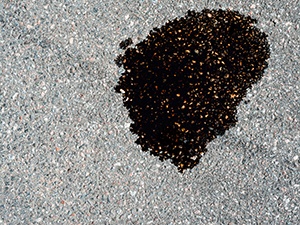If you have a driveway or garage, the odds are good you have at least once in your life encountered oil stains and discovered that they don’t hose off very well. So, how do you get the stain out?
One option we recommend is to use Stain Reaper by MB Stone Care (www.mbstonecare.com). It’s a favorite of many stone and concrete restoration professionals, because it works. Stain Reaper is a ready-to-use, low-odor paste poultice. It pulls deep-seated oil, dirt, harmful salts and other embedded stains out of sensitive masonry, even polished limestone and marble. No mixing is needed, and it is easy to use. It is safe for all natural stone.
d-Limonene
Another common treatment is to use d-Limonene, which is commonly used as maintenance cleaner for concrete pads, parking complexes, and airport runways. The oils and greases that drip from cars can be lifted off the concrete with the application of either straight d-Limonene or a water-diluted product. With straight d-Limonene, it is applied directly to the oil spots. The d-Limonene lifts the oil from the surface, so it can then be absorbed with a solid media such as kitty litter or oil absorbent pads. When using a water-diluted product, use the traditional mop-and-bucket method. Some d-Limonene/water products have also been used in small floor scrubbers for removing oil and forklift tire marks, and in larger units for taking up tire marks in garages.
Whichever option you choose, make sure you don’t ignore the safety requirements – you are, after all, working with chemicals. Follow the directions on the package carefully and don’t be discouraged if it takes more than one treatment. If the stain goes deep or has been sitting a while, it could take multiple applications.
Enzymes to Clean Up Oil Spills and Stains
The most recent advancement in the removal of oil stains from concrete involves using special single-celled microorganisms that thrive on crude oil and its derivatives, eating them up like candy. Enzymes and oxygen digest the oil and turn it into carbon dioxide and more microorganisms. When the food source (oil) is gone, the microorganisms die, leaving the concrete clean and oil-free. This is the same technology used to clean beaches and waterways after large oil spills. There are several of these types of products on the market today. Do a search on the web for ‘enzymes to clean up oil.’ You’ll find several options.
Consult A Professional
If you have neither time nor inclination to DIY, or you’d like some advice before you start, never hesitate to consult your restoration professional. We are always happy to answer your questions.
This is one of a series of articles written and published on behalf of Stone and Tile PRO Partners.




